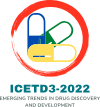Speaker
Description
Sansevieria cylindrica (SC) and Plumeria obtusa (PO) plants have been investigated for diverse pharmacological activities, but the safety and/or mechanism of toxicity is still lacking in the literature. Subacute toxicity studies will add value to the drug's pharmacological profile. The dose of drugs for this study was decided by limit test. The present study evaluated the toxic potential of plant extract through repeat administration for 28 days in male and female wistar rats. An acute toxicity study was conducted initially and a limit dose was determined. Based on this data, sub-acute toxicity was planned and carried out with the oral administration of repeated doses of 200 mg/kg/day and 400 mg/kg/day; body weight (b.wt.) for 28 days. All animals were equally divided into three groups (n= 6) with each group containing 3 male and 3 female rats. The toxic signs, mortality, and body weight changes along with neurotoxicological assessments (Functional Observation Battery and Locomotor Activities) were recorded. On day1 and 29 the rats were anesthetized to collect blood for estimation of hematological and biochemical parameters. Animals were sacrificed to collect internal body organs for weighing and histopathological studies on day 29. The plant's extract has no major adverse effect on the body weight, food intake, biochemical and hematological parameters, and internal body organs. No mortality or any major sign of morbidity was recorded. However, minor variations were observed in treatment groups compared to the control group. Oral administration of SC and PO hydro-alcoholic extracts did not cause any systemic toxic effects. In conclusion, the no-observed-adverse-effect level (NOAEL) of these extracts in rats was found over a limited period after repeated administration and supports its exploration as a future medicine.
